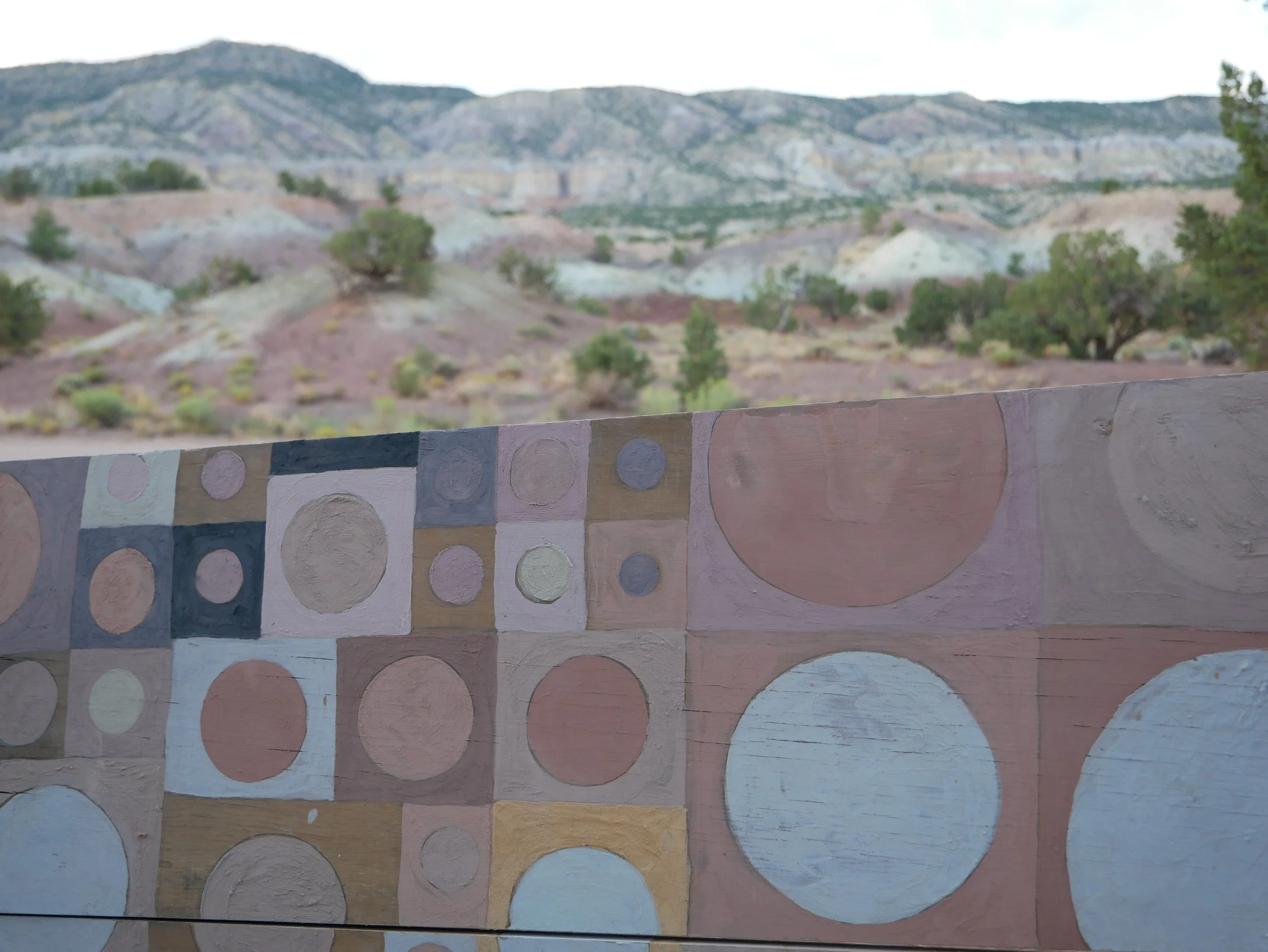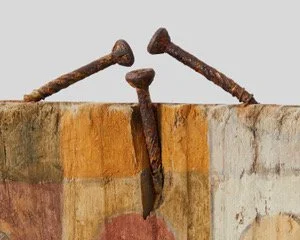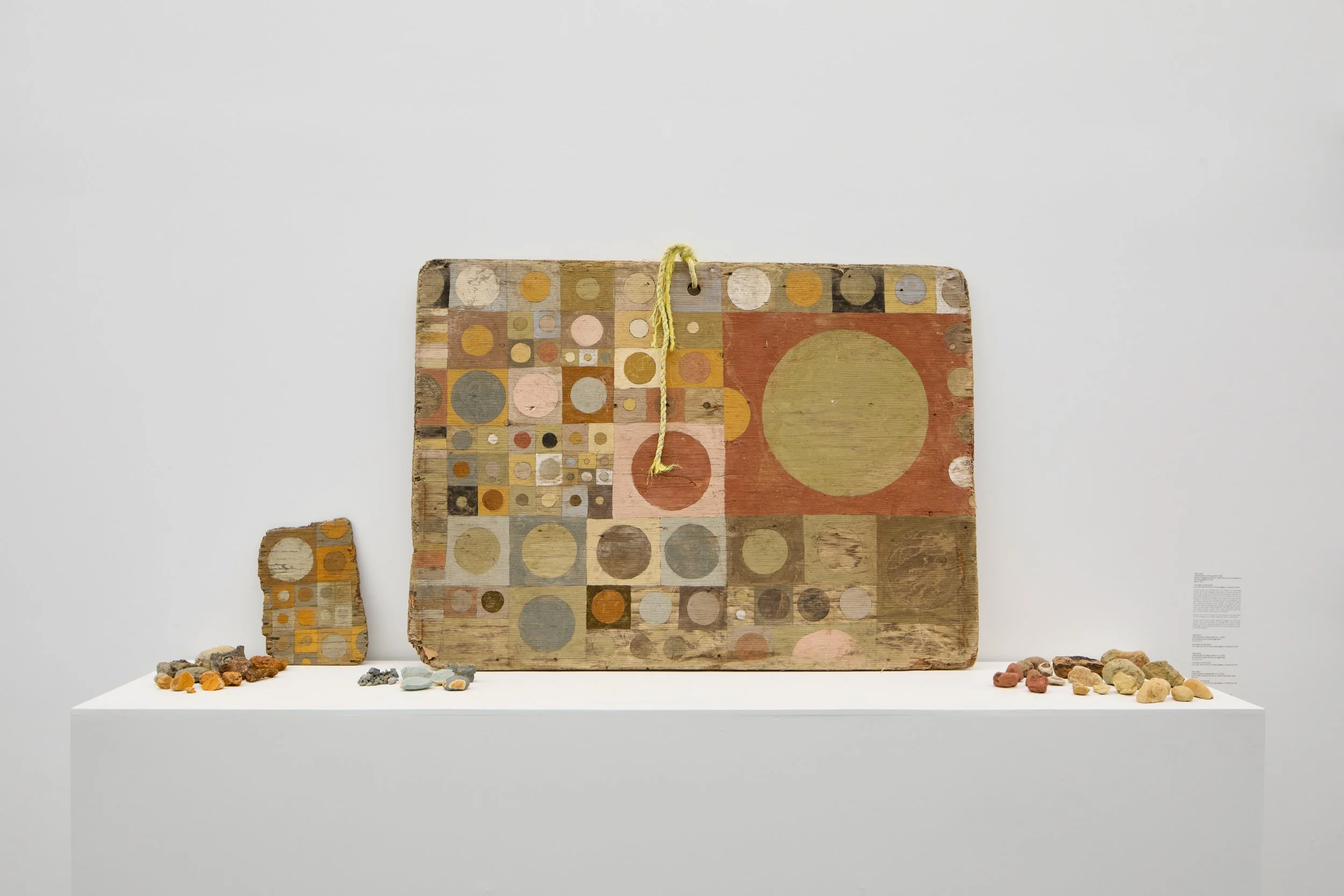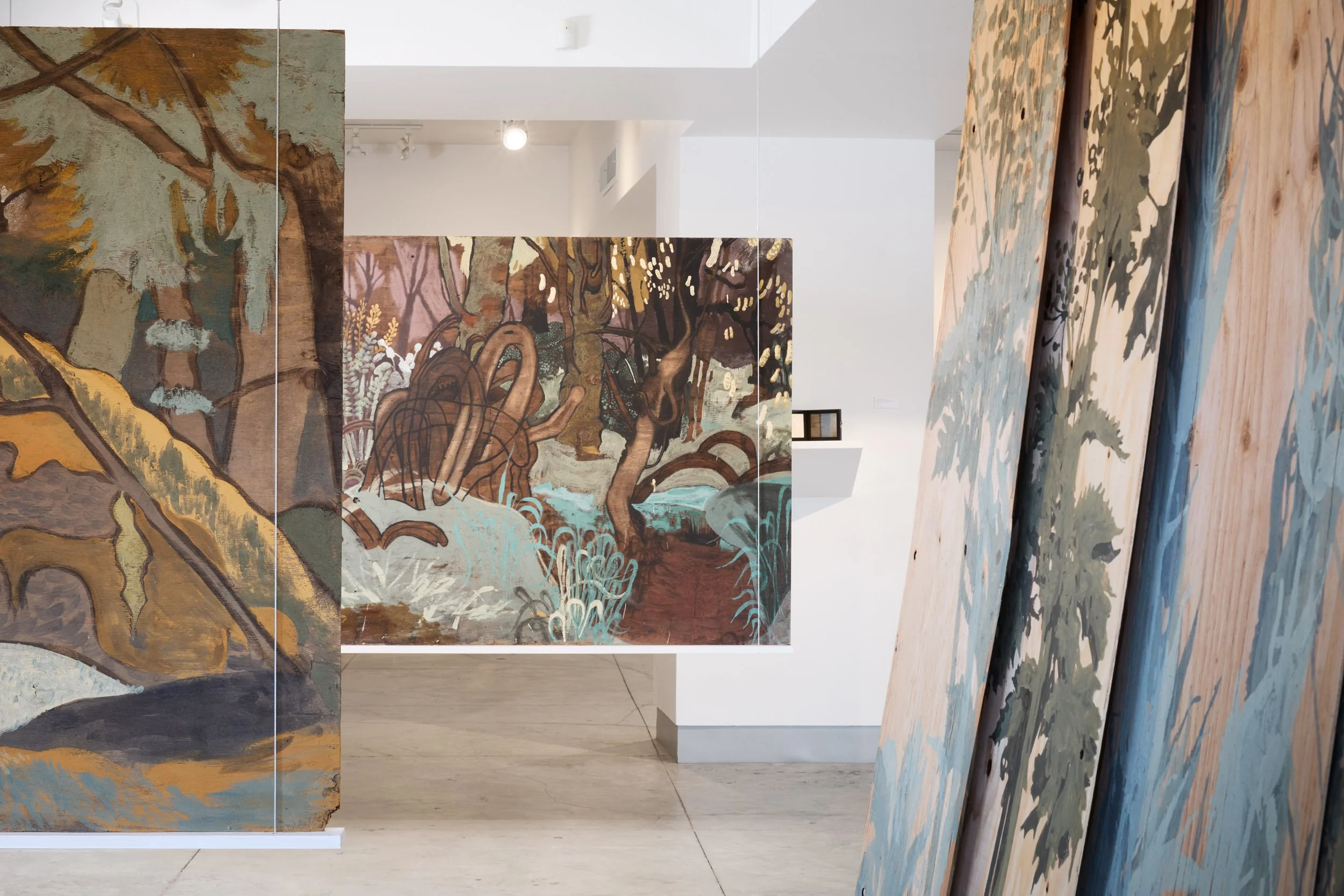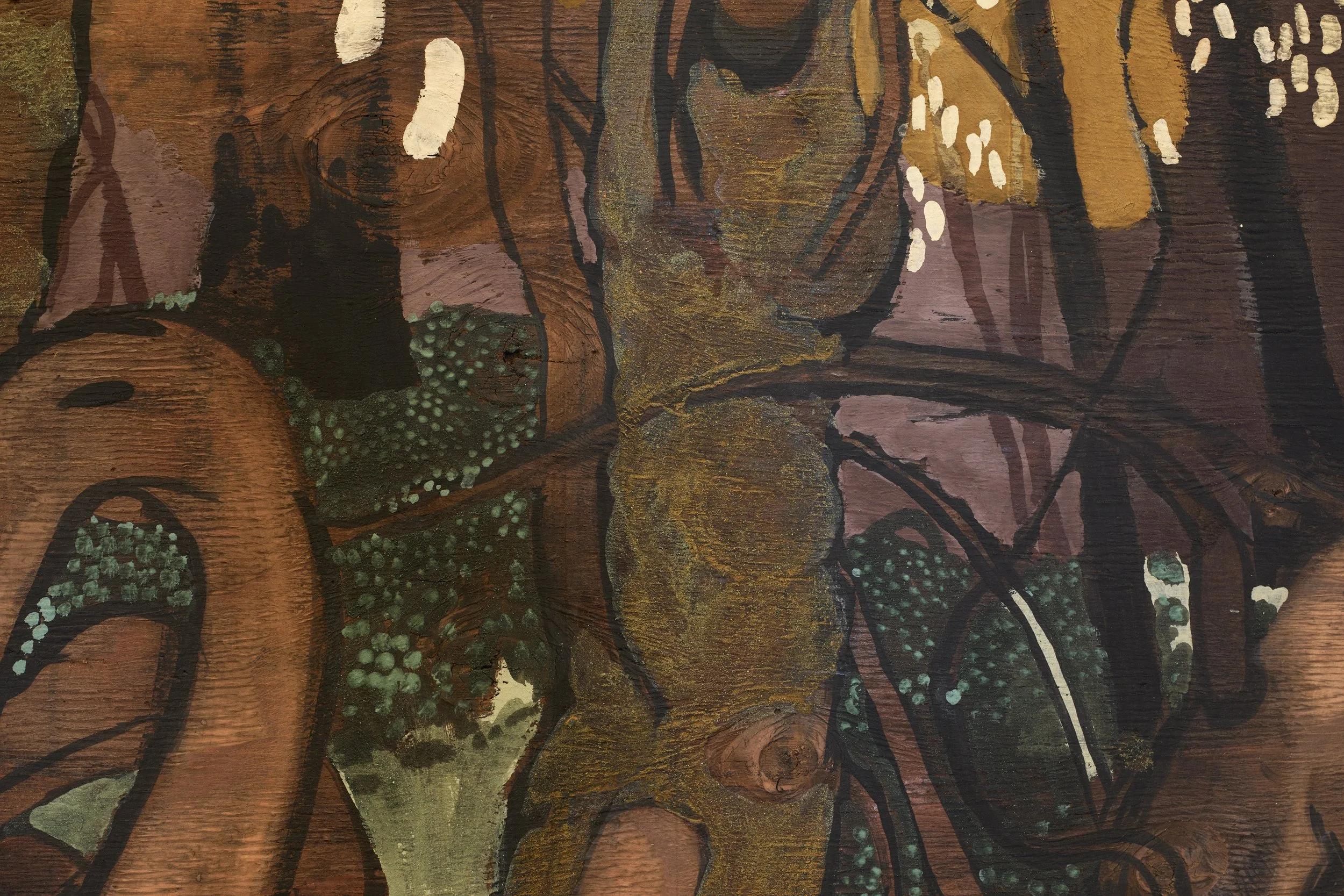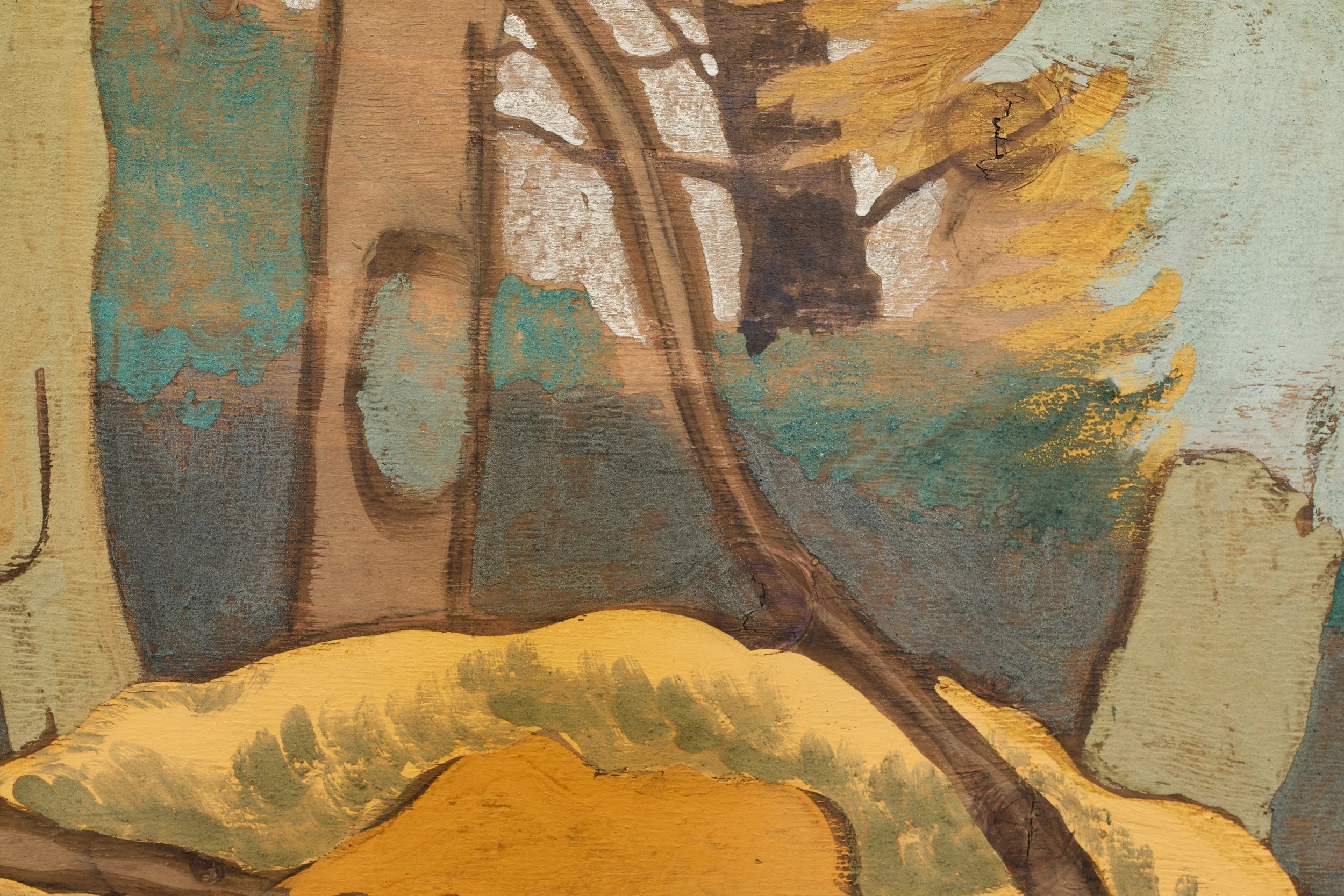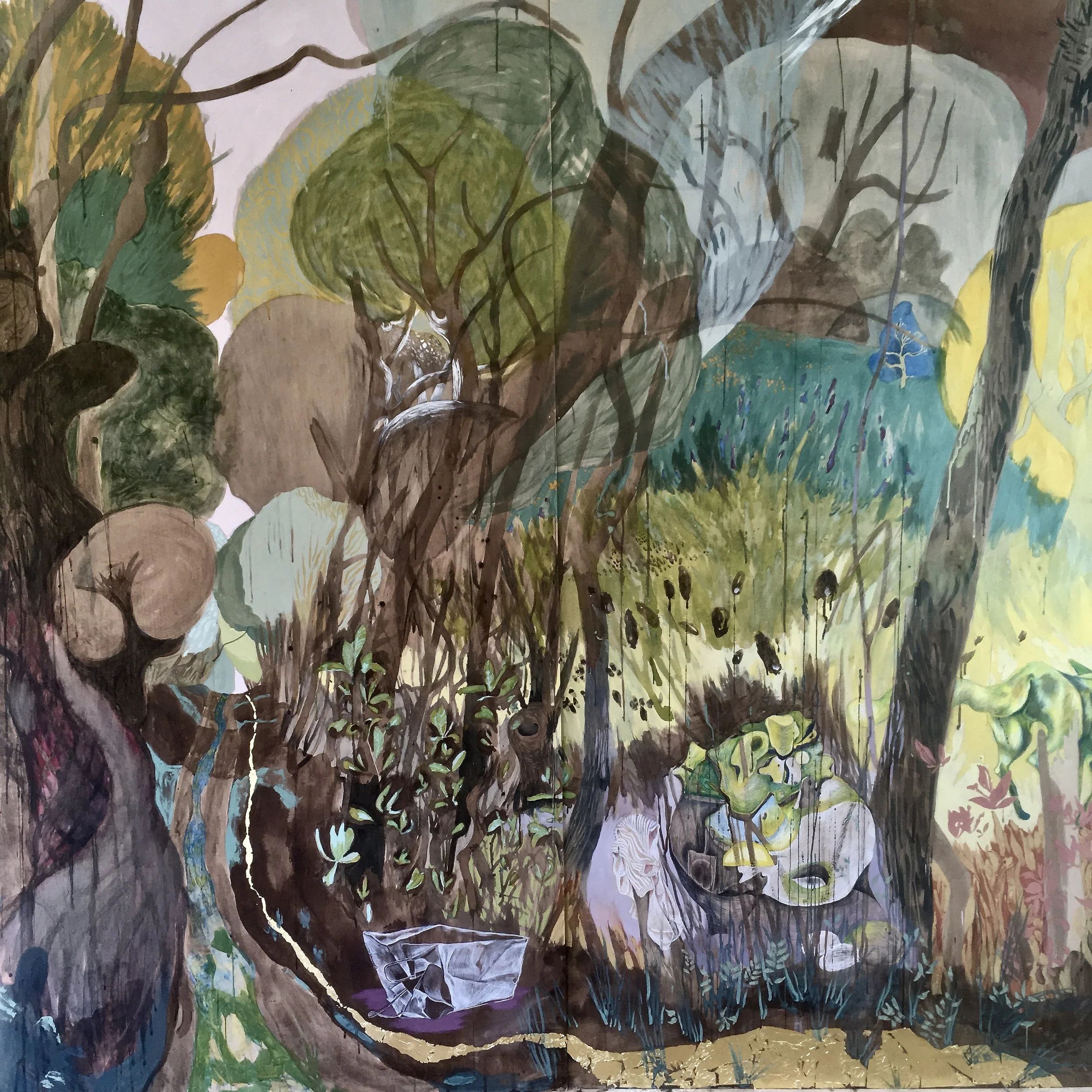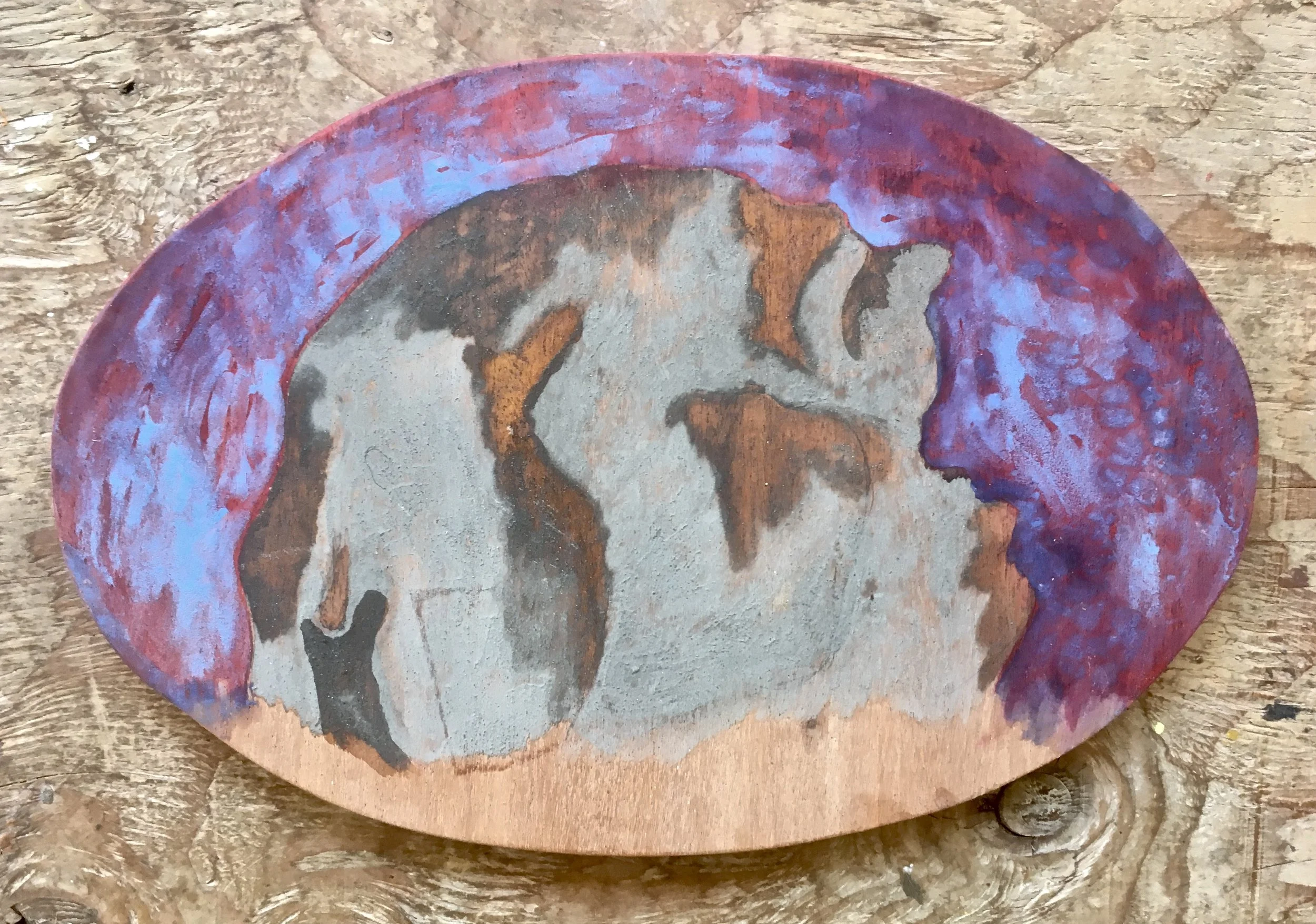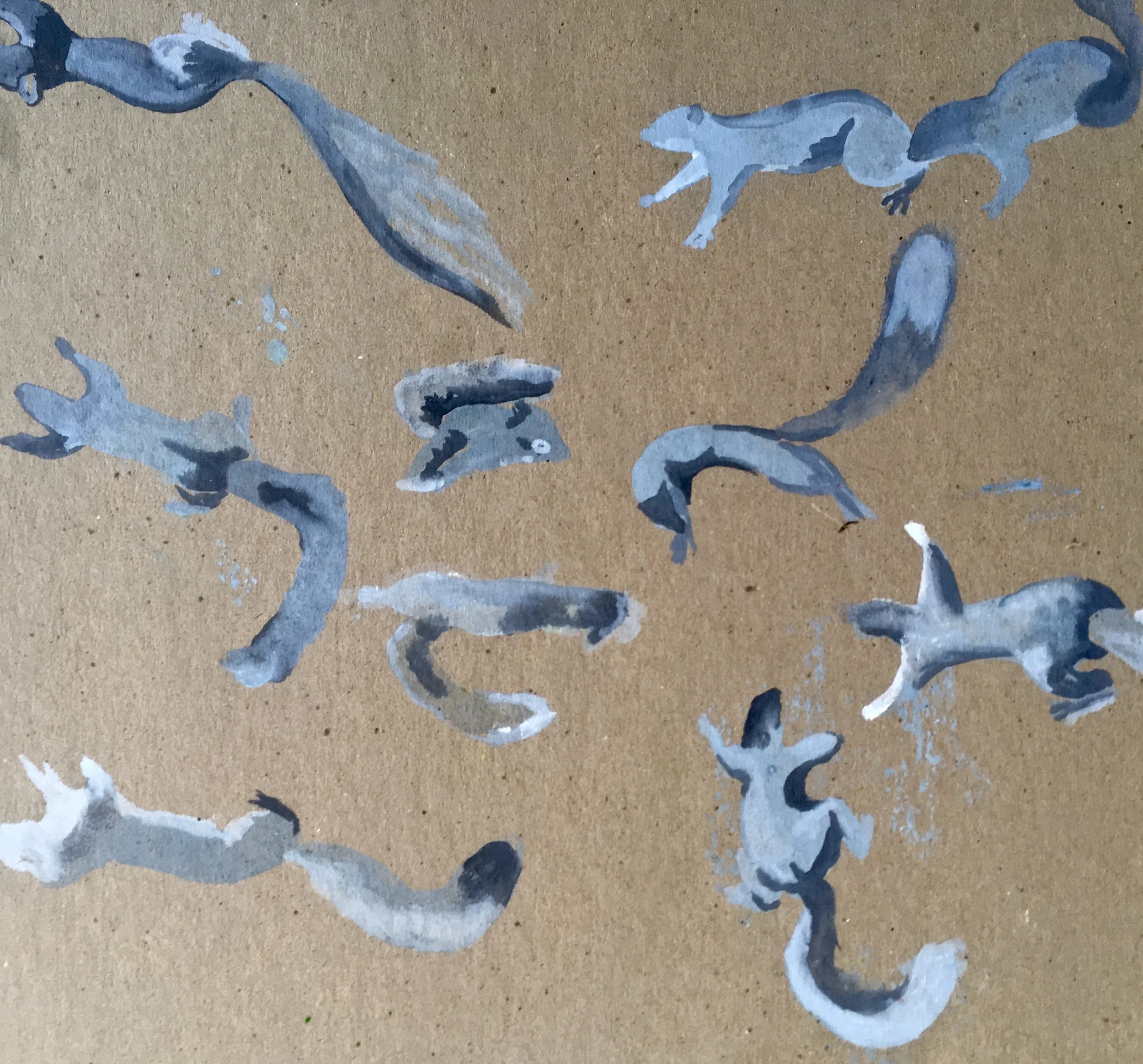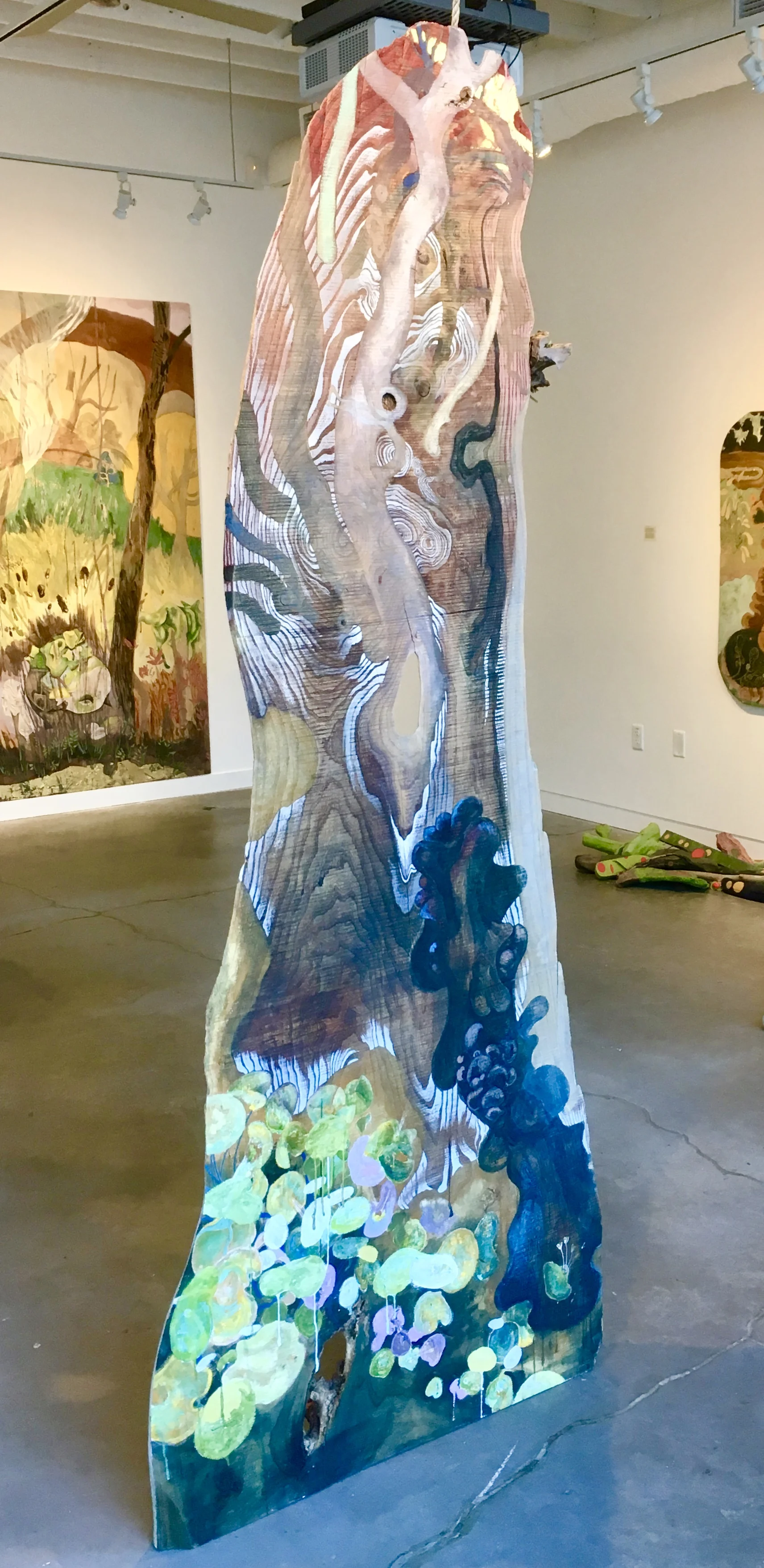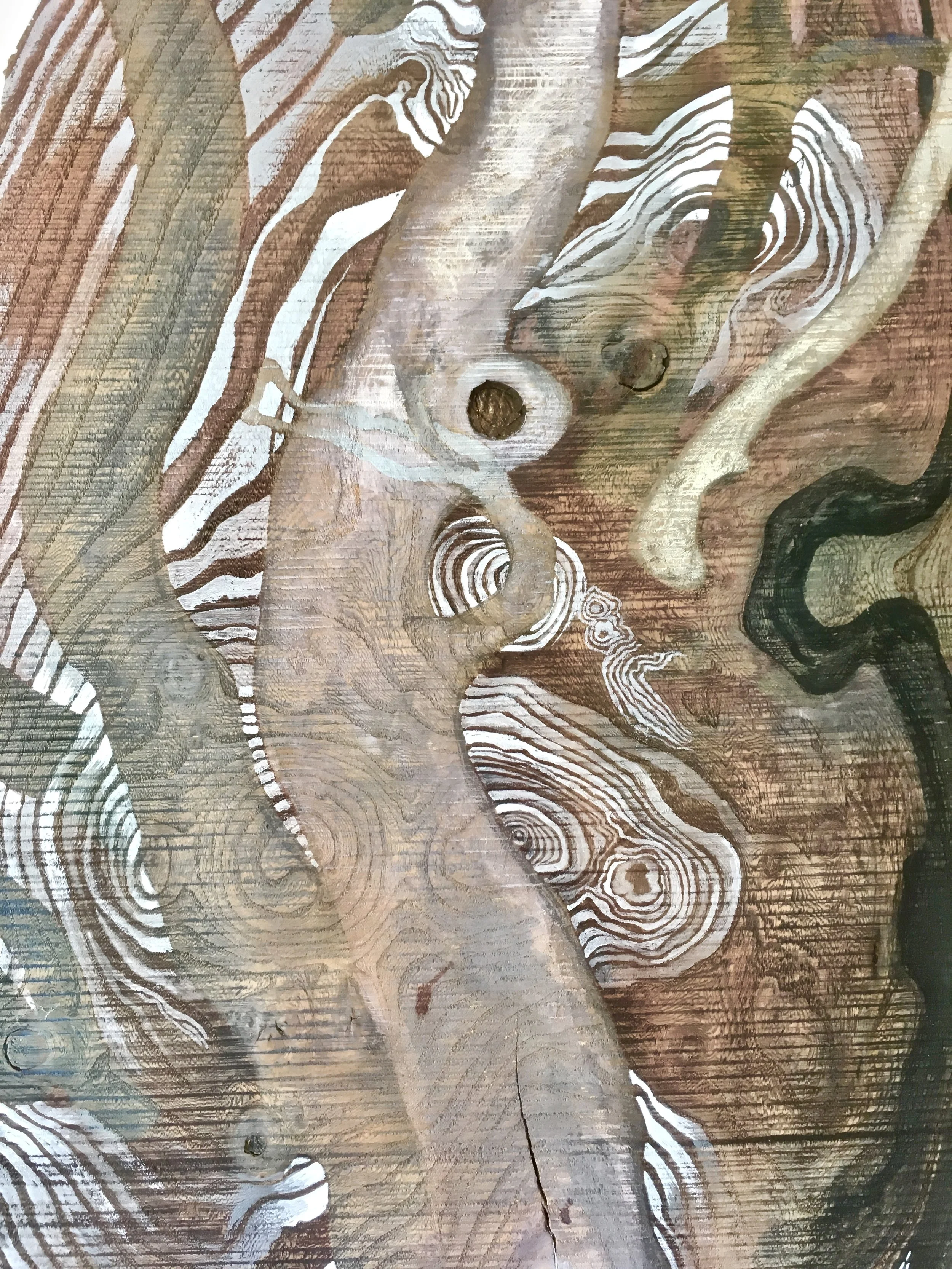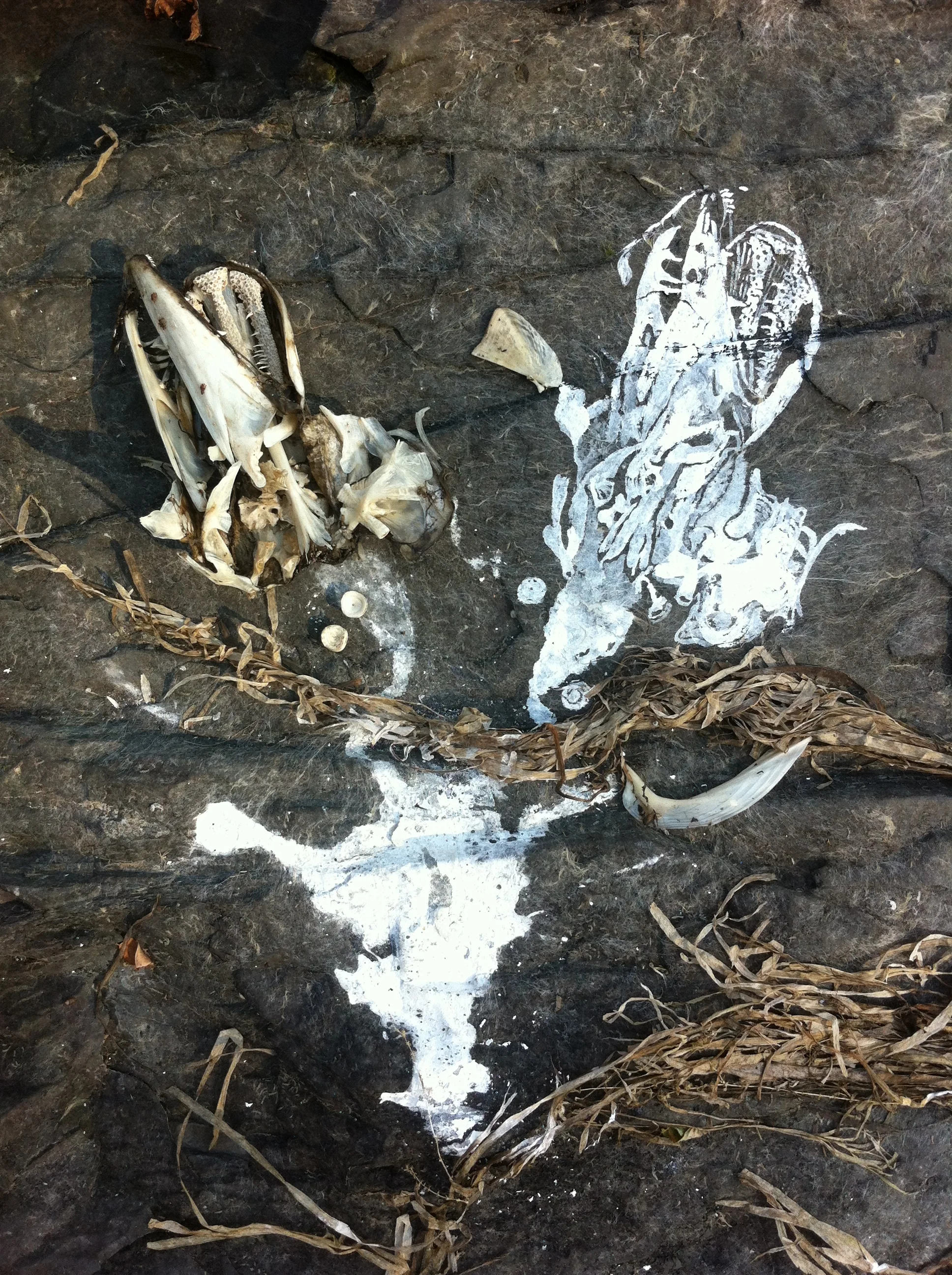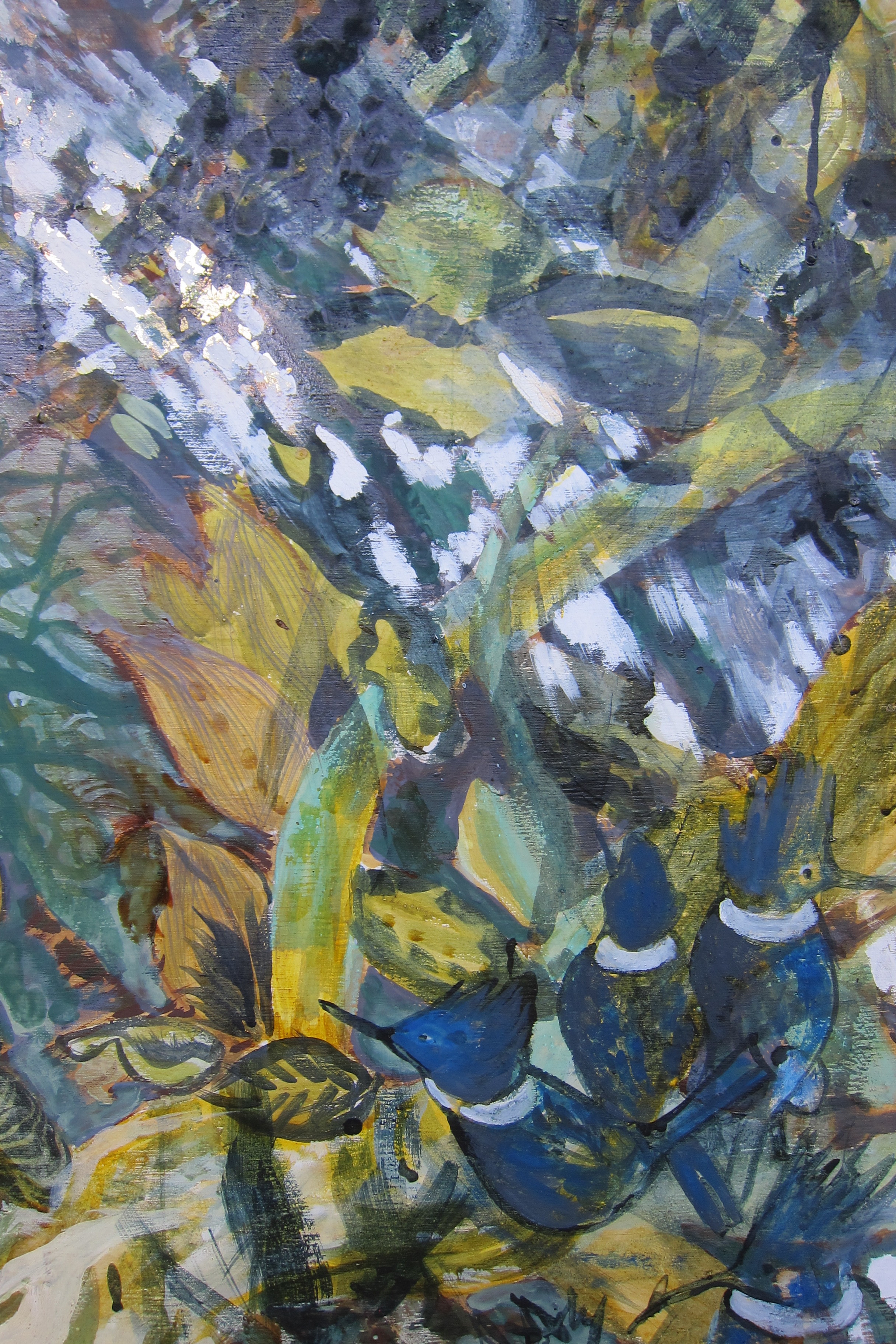ceremony for being with no.3
CEREMONY FOR BEING WITH RIVER RED PLACE
Reclaimed wood scrap, mineral & carbon pigments site specifically foraged and ground into paint, graphite pencil.
22.5" x 49.5" x .25"
Ceremony for Being With River Red Place ( a translation of the Tewa name for the river that is colonially known as the Chama RIver: 'P'op'įgeh,’) begins with iron oxide, charcoal and calcium carbonate pigments, ground, mixed with river water, and applied to three boards loosely held together with rusted nails, onsite in the desert near Red River Place. The painting came into being as part of a developing relationship between artist Tilke Elkins, and the site. The artist purchased the board for two dollars from neighbor Cecilia Rios, who runs the woodlot near Canyon Road that came into her family in the 1930s, and has remained there because the family has recognized the value of keeping the land in the family despite its outrageously escalated value. The board will be offered for sale, while the pigments will be offered for rent only, for a five to ten year period. The rent money will go to Flowering tree Permaculture Institute, through artist/educator Roxanne Swentzell.
Please contact Tilke at connect@ceremoniedart.org if you’re interested in entering this ceremony as a supporter.
The painting is accompanied by the following text, Ceremony for Being With River Red Place, written by Tilke Elkins.
CEREMONY FOR BEING WITH RIVER RED PLACE
The valley draws you in. Across the wide sage fields stand the cliffs, their familiar bands of purple-yellow-white-pink in a stacked pastel rhythm towering along the edges of your vision. This valley starts wide and gets narrower as it curves, closing around the river, bringing you towards to the rough limestone, tuff, basalt walls and the piles of colored sand. The milky green river is cold.
You hesitate at the bottom of a tall, particularly vibrantly hued mound of layered earth in purple, pink and green. You wonder, hard, if you should be there, if you should be with that place at all. You wonder if your very presence is a sign of disrespect. You know, from recent conversations with friends, that a lot of blood has been shed in that valley, between people who were there for generations, and between those people and people who arrived from afar by boat and captured and enslaved as many people as they could. You know that the beauty of the place has been seized and culturally broadcasted and dominated by Euro-American artists since the 1930s.
The green sand at the base of the tall mound is warm. You look up at the place where the mound's purple zenith meets the sky. You feel "yes," like an exultation. You climb upwards, carrying the long wooden boards loosely held together with rusty nails, your feet sliding in the sand. You perch at the top, feeling the sand take the shape of your body under you. Your hands find hard rocks within arm's length, hard quartz very different from the sand, scattered on the other slope of the mound. One large, and flat -- another, round, and flattish on one side. You pile pink sand on the flat rock and pour river water from a plastic bottle you found by the river onto the sand pile. The pink pile deepens to a red. You place the round rock with the flat side on the wet red pile and begin to grind. You press your finger into the smooth wet ground sand and wipe the soft, colored mud on the back of your left hand. It dries quickly in the sun-heated air, turning from dark red back to a pink that makes your skin look yellower. You do it again, this time rubbing in a circle, rubbing a series of circles on the back of your hand.
You have brought a pencil and a paintbrush with you, in your shirt pocket. You take out the pencil, and begin to draw circles on the piece of wood. Big circles first, following each other in the arc that the circle of the green river takes. Then more circles, all sizes, filling around the river in shapes that feel like the undulations of the land and the cliffs. You make lines between all the circles. When the drawing is done, you turn back to the ground sand, which has dried. You put your pencil back in your pocket and take out your paintbrush. You rewet it, and begin to paint, crosslegged in the sand with the board on your lap, bending over. When the paint is gone, you stand up and walk-sink back down to the base of the mound. You bring a small handful of green sand back up with you, and grind it soft. As you grind, you notice dark clouds pushing, in the distance, over one side of the valley. You wonder if you will have to leave.
Small gusts of wind lift the edges of your clothes as the dark clouds get closer. Sand scatters over one corner of one of the boards. Soon you can see the pendulous white sheets of rain hanging down from the dark distant clouds. You marvel at the illusion of motionlessness that the hanging white sheets give, knowing the furious activity of raindrops actually going on in there. Soon, the edge of the storm is almost directly above you. But the wind does not pick up. You stay dry. You watch the lower landscape darken with an inrush of water.
Some people close to you who have been out walking are hidden from view, making reverent sounds that echo off the high cliff walls. You feel a collective being-with. You feel a joy from the land. You feel a kind of relief in your presence, like a nourishment after thirst. You keep painting, grinding, painting.
When you leave the valley, you drive out towards the clouds and the wet land. From a high place, you can look down and see that the green river is stained deep red. The red of the land has run into it. Above the river, against the still black-dark clouds, hangs the most dramatic quadruple rainbow you have ever seen, irreplaceable in words or image. It is a rainbow of comic proportions. No one says anything. You just roll the windows down, breathe in the wet air, and let the bright shape of the rainbow place itself, upside-down, on the dark fiber of your retinas.
ceremony for being with no. 1
CEREMONY FOR BEING WITH, NO. 1 / CEREMONY FOR BEING WITH SALMON RIVER, 2023 / Tilke Elkins
timeframe: invoked in 01.23, painted in 02.23, sold in 11.24, rent on-going, end date 11.27 or 11.30
materials : found wood scrap, five-and-a-half inches by twelve inches, mineral and carbon pigments site-specifically foraged & ground into paint — a handful of soft mineral clumps & rocks in red, yellow, and blue iron oxides, white clay, and charcoal from a burned douglas fir stump
participants: Sitka Center for Art & Ecology community, artist/Grand Ronde tribal elder Ann ‘Nestucca’ Lewis, Sitka residents artist Orchidia Violetta and Danielle Vogel, high school teachers, and 7 high school students
supporter/purchaser: Kelly Booth
land stewards: Chachalu Museum & Cultural Center; contact David Harrelson
description
this ceremony begins on the rocky beach the mouth of the Salmon River on Nechesni/Confederated Tribes of Grand Ronde lands (colonially known as Cascade Head, Oregon) and was initiated during an artist residency at the Sitka Center for Art & Ecology in February 2023. the foot-long piece of wave-worn 2 x 6 that washed up on the shore holds an exploration of color juxtapositions or ‘color tests’ made with crushed iron oxide minerals & charcoal from a massive burned douglas fir stump. these pigments form a nexus point for a network of relationships, and will eventually return to the river and ocean tides.
the first network of relationships, between artist tilke elkins and the inter-being community at the estuary formed during tilke’s daily time at the convergence of river and ocean, for five weeks in january and february, 2023. tilke settled into time ‘being with’ the river, the ocean, and the layers of sandy and rocky beaches between the two, connecting with the loose, wave smoothed minerals, and the minerals in the crumbling cliffs along the shore. sitting quietly grinding small fragments of soft rocks and hard clays into a wet paste between hard rocks, tilke also took part in intuitive dialogues with an otter, many seals, a pacific wren, fox sparrows, nettles, an alder tree with a low, bench-like branch, muscles, seaweed, diving ducks, several very old sitka spruces and a group of eagles.
the next ring of relationships formed between the place, tilke, and other humans.
tilke received much support and stories about the Sitka center land and past residents from assistant director, Nancy Newman and administrative director Nicola Harrison. reading through the record of past residents who stayed in the cabin assigned to her, she observed a note from artist & friend Nina Elder: a crossing of paths through time. walking high on the hills overlooking the ocean, she thought of the passages in the chapter Burning Cascade Head, from Braiding Sweetgrass, by Robin Wall Kimmerer, written during Kimmerer’s residency at Sitka.
Sitka Center artist residents, Danielle Vogel and Orquidia Violeta were co-dialoguers with the inter-being communities at the confluence of the river and the pacific ocean. textile artist Orquidia held conversations with elk and moss, making intricate cloth prayers — including Wapiti and Salmon Year. poet / ceremonialist Danielle Vogel recorded the underwater songs of the estuary and collaborated with plants and place to make liquid extract essences which hold the energetic imprint of the place. conversations about art-as-ceremony were influential. Orquidia, Danielle and tilke spent wordless time being with these communities — in particular, one night during a full moon, they climbed a dead tree on the edge of the estuary and dialogued with the wind.
during a visit to the Chachalu Museum and Cultural Center, tilke, held a local stone mortar and pestle that was several thousand years old. she briefly met David Harrelson, the historian for the Confederated Tribes of Grand Ronde, who later connected her to artist and Grand Ronde tribal elder Ann ‘Nestucca’ Lewis, whose Nechesni relative once lived down the beach from the Salmon River. Lewis and four friends visited tilke at Sitka, where they gathered pigments, made paint and spent time being with an ancient ochre site.
months after the residency ended, tilke returned to Sitka to meet at the estuary with a group of seven art students from Nestucca High School, along with Sitka youth program director Leeauna Perry and Nestucca High art teacher Sydney Leja. together they explored the riverbanks and beaches, looking at ochres, making paint, and painting the surfaces of found wood. one student, who particularly connected with the pigments, interned at Sitka later that summer and took an oil painting class. after time with the students, tilke stayed an extra night at Sitka — a gift in reciprocity for time with the youth — and painted with beach charcoal in a sitka spruce grove with trees who she got to know during her residency, continuing the conversation.
financial model: extending relationships
through Wild Pigment Project social media, tilke was approached by artist / book designer Kelly Booth, who was interested in a supportive relationship in the ceremony. in novemebr 2024, Booth purchased the board that the Ceremony for Being With Salmon River painting sits on, for $222.00, and rented the pigments for $111.00 / year — 150% to 600% of the sale price for the piece. the rent money goes annually to the Chalalu Museum and Cultural Center, facilitated by David Harrelson. at the end of a three or six year cycle, the pigments will be washed off the board and returned — by Kelly, tilke, or both – to the place where they were ground to paint and painted. Booth will retain the board. tilke will receive an artists’ resale commission if the board is resold at any time, and if sold before the end of the first three-year term, any new buyer(s) will continue the pigment ‘rent’ agreement.
the painting hangs on a wall in an area in Booth’s house on Ohlone lands (cka the Bay Area, CA) where she often holds small, intimate ceremonies with friends, and has been the focus of many ongoing conversations.
ceremony for being with no.2
Ceremonies for Being With, on view at the New Mexico State University Museum, as part of the Wild Pigment Project Group Exhibition (July 22nd through September 16, 2023) is a painting made with site-foraged minerals on found plywood at the spot where the wood was washed ashore by the winter tides, at the mouth of the Salmon River on Nechesni lands (colonially known as Cascade Head, Oregon). Produced during an artist residency at the Sitka Center for Art & Ecology in February 2023, the plywood board that holds the paint is available for sale, while the pigments are offered for “rent” only, by the year, to be washed off and returned to the Salmon River when the rental period ends. All rent funds will be directed to the Sitka Center for Art & Ecology to be offered as stipends for the Indigenous Place Keepers artist residents.
The painting is accompanied by a recording of text, written and read by Tilke Elkins. Listen here.
CEREMONIES FOR BEING WITH
Ceremony for Seeing and Being Seen
Your eye seeks other eyes. The eyes of the birds are often too small or too fast to see. The eyes of seals merge with the shining domes of their heads. The eyes of otters are avoidant. The eyes of elk are deep and watchful but it’s impolite to stare back.
Your eyes seek out the eyes of the land. Without trying, your eyes scan the ground at your feet for other eyes. Rocks with improbable round shapes at their centers. Worn driftwood with perfect circular holes where the knots have fallen out. Circular puddles in the tops of boulders.
Gather the eyes that can ride in your palm. Walk a few paces. Feel their weight. Examine their circles, their layers of geologic mystery. Arrange them on a log or on the other rocks, facing you. Let them take you in.
Feel the seals, the otter, the chirping eagle, the diving ducks, the seagull, the fox sparrow, the golden wren watching you. Feel the eyes of the sun and moon watching you.
Ceremony for Being With Color
See the thin band of red earth in the cliff that rises over the rocky beach. See the red rocks, the ones that looked at first like brick shards worn by the waves, scattered occasionally between all the grey and brown rocks on the beach. Pick one up and smooth it with your fingers. Feel its greasiness, like dense lipstick. Lick your finger and make small circles on its surface. See the deep red appear on your finger pad. Feel the strangeness. Feel the specialness. Feel your heart speed up.
The next day, walk past the red seam. Walk over the brown rocks and the grey rocks and the white rocks. See a rounded yellow-orange rock wedged between two brown rocks. Pull it out and dig your fingernail in. Feel the softness. Pinch it between your thumbs and the sides of your index fingers to break it in two.
For the next two weeks, pick up rocks. Hold them, walk with them, put them down. Place them on logs according to color and texture. Hide them under the logs when you leave. Sometimes, don’t. Carry some up the hill with you and crush them in a stone mortar and pestle. Back on the beach, crush them on flat rocks and mull them with smaller flat rocks. Carry water to those rocks in a large broken clam shell from a stream down the beach. Spill half the water. Find flat rocks within arm’s reach of the stream instead and sit there, using the broken clamshell to scoop water onto the mulling stones.
See the unusual large round white stones below the high tide line. Cover one with the red ochre paint. Feel suddenly exposed. Feel dread. In the morning, check to see that the tide has taken the red paint away, It has. Decide not to paint the white rocks again. Find a large weathered piece of plywood with a frayed yellow rope tied through a hole in the top. Decide to paint this, instead.
Make tiny piles of each of the colored rocks you’ve crushed on a large flat stone. All the colors, as many as you have. The dark red ochre, and the paler pink ochre. The deep bright yellow-orange ochre that came from that one rock. The slightly paler yellow bright ochre that came from several rocks. The three blues: the one that came from the puzzle rock that collapsed into hard blue shards when you lifted it. The one that came from the pale blue vein in the sand that was edged with thin sulfurous yellow. The slightly greenish sandy one that was encased in beige ochre like an egg. The dark olive green one that looks brown whenever it doesn’t look green. The pale yellow that crumbles audibly from the cliff next to the place where you paint, making sounds like someone small creeping up behind you. The black, charcoal from a massive burned stump that was reluctant to give up its charred scales, making you promise to use every speck you broke from it.
Just as you scoop all these out onto the flat rock, listen to the quiet inner voice that says, not yet. That says, wait. Stop, and wait. When the hard rains start not long after, feel grateful. Instead of leaving the beach, go the other way. Find an improbable cave under a boulder, nearly overtaken by surf, deep and high enough to stand in. Feel the humanness of this place. See where the edge of the boulder has turned from yellow to red, as if calcined by a fire. See the small notches in an ascending line on the side of a rock face, like a ladder. See the bowl-like depressions in a large rock by your foot. Feel the subtleness of stone architecture. Watch the heavy rain blowing in waves on the surface of the ocean. Feel dry and cold.
Hear the voice that says, now. Find a thin flat rock like a plate or a tray, and squat down. Use the flattened end of a stick to scoop the dry color powders onto the stone tray, in an array of beauty. Use smaller rocks for levels. Drink in the colors with your eyes. Their abundance. Their miracle. Feel the stone walls drinking them in. Feel a thirst, there. Know that you will leave them. Know that to leave them in plain sight would interrupt an unspoken agreement. Know what the right thing is.
Step to the edge of the overhang and place the tray just beyond it on the ground in the rain. Watch as the drops land on the piles of dusts sending up soft puffs of color. Watch as the colors turn dark and run into each other. Watch as they run off the tray.
Walk back along the beach in the almost dark. There’s a yellow you’ve never seen before, a big piece, smooth and dense. Put it in your pocket. Walk. Wait, there’s a green, the one you’ve found only once before. Is that it, really? It’s almost too dark to see. Yes, that’s it. Put it in your pocket. Before you can take another step, there’s another one, a blue this time, perfectly soft. And here, a new dark purple. Here, a soft white. Your pockets are heavy, and you’re laughing. There’s all the color you could ever want to give back to this place.
Ceremony for Being With Rain
When the rain starts, gauge its speed by watching the dots of darker color appear on the painted surface of the board. When the dots come faster and cover the surface evenly, lower the board, paint-side-down, to the rocks. Sit down. Watch the spaces between rain dots on each rock narrow and then disappear as the whole rock darkens. Consider getting up but see that the rocks under your legs are still light-colored with a few visible dots. Stay with the rain.
Watch the waves, close and loud at high tide. Feel the urgency of their sound pressing in. Watch the surface of your boots and the thin fabric or your rain paints and jacket darken. Feel the gentle pressure of the rain on the tops of your arms and legs. Feel the gentle pressure of the rain on the top of your head. Feel cold but dry. Feel patient. Feel the efficiency of sitting quietly in the rain instead of hurrying away. Feel the safety of water. Feel the sadness of waiting.
Hear a sharp chirp from a nearby log. Watch a small golden wren disappear under the log. Long to see the small golden wren. Watch the small golden wren’s head appear suddenly three feet from you from under the log with a sharp chirp, and instantly disappear. Feel the sadness of waiting lift.
See a crumble of yellow ochre by your foot and set it on the top of a flat rock. Crush it with a smaller rock and let rain fall on the crushed rock. Feel the effortlessness of instant water. Mull the rain into the rock until the paste is smooth. Scrape it off with your finger and into a half muscle shell. Set the shell under a large thin rock to keep more rain from falling in the paint.
Feel an openness, as the tide pulls away and quiets, and the sky gets light. Jump up. It’s still raining, but so much less. Raise the board at an angle and crouch under it with the shell of paint. Apply the paint to the board with your finger, in a circle, using your fingernail to make the edges crisp. Watch small specks of rain blow on to the undersurface of the board. Feel unconcerned. Finish the circle and reluctantly lower the board as the rain darkens it.
ground bright leaves
KEY TO IDENTIFY GROUND BRIGHT PIGMENTS
***Note: The 47 pigments from 33 artists that have been featured in Ground Bright, Wild Pigment Project’s monthly pigment subscription can be identified through comparison with each other. This method of identification requires close observation which increases intimacy with the material through direct sensory experience. The following descriptions facilitate the comparison.
REDS, ORANGES & PINKS
RED OCHRE (Heidi Gustafson) & TELEPHIC RED a blend of iron oxides from alchemically transmuted gun metals, (Thomas Little) are very similar. RED OCHRE is slightly more yellow, and slightly less saturated than TELEPHIC RED. TELEPHIC RED has a smaller ball, and a leaf with a rounded tip.
ANCESTOR BROWN (Lucille Junkere) is a deep bright red-orange-brown, more yellow than GAYULI (Melissa Ladkin), which has a smaller ball and is ever-so-slightly pinker.
RED BANK RED (Amanda Brazier) is a bright light orange with a darker orange ball.
OCCANEECHI SHIMMER (Kelly Moody) is slightly pinker than RED BANK RED, and is flecked with lots of mica sparkles.
OAK CREEK IRON (Kelly Moody ) is pinker than DART RED OCHRE (Caroline Ross ), which has a big leaf and a very big ball, and is not as pink as SE OREGON.
SE OREGON (Nancy Pobanz ) is a warm middle pink and the leaf shows signs of brushmarks.
GLACIAL BONES (PINK) ( Heidi Gustafson ) is lighter than SE OREGON but not as light as MULLUMBIMBY PINK ( Karma Barnes ) which is the palest pink.
COMB WASH (Nancy Pobanz ) is a brilliant deep orange-pink.
DART OCHRE (BRONZE) ( Caroline Ross ) is a soft, pale orange-brown, much less saturated than RED BANK RED.
GREENS & GRAYS
KALAPUYA COUNTY (Tilke Elkins ) is a warm, brownish green that is the deepest, darkest green.
HOPI / TURTLE ISLAND LAKE ( Julie Beeler ) is slightly paler and bluer than KALAPUYA COUNTY and has a very dark, almost black ball.
WHILAMUT ( Tilke Elkins ) is cooler, bluer and paler than KALAPUYA COUNTY.
HILLSIDE SLOUGH ( Teri Power ) is a warm, soft, pale brown-green that is slightly yellower than ROCK FLOUR ( Nina Elder ).
DAPPLE GREEN ( Elpitha Tsoutsounakis ) is a pale, soft blue-green that is an ever-so-slightly more saturated green than CELADONITE ( Melonie Ancheta ).
CELADONITE is almost imperceptibly bluer and paler than DAPPLE GREEN, and has a smaller ball than DAPPLE GREEN.
TULIP / TURTLE ISLAND LAKE ( Ashlee Weitlauf ) is a bright light green with a gritty ball.
POPOLO / TURTLE ISLAND LAKE ( Avalon Paradea ) is the palest green, almost white, with a gritty ball.
GLACIAL BONES (GREY) ( Heidi Gustafson ) is a soft grey, bluer than ROCK FLOUR.
VIOLETS & PURPLE-ISH BROWNS
SPOILS (Caroline Ross ) is deep maroon with mica sparkles, on a big leaf.
UNDERLOG (Tilke Elkins ) is warm soft chocolate brown.
EXTINCTION HEMATITE ( Tilke Elkins )is violet, paler than SPOILS and darker than CAMAFEEMA ( Tilke Elkins ).
CAMAFEEMA is a lavender hematite, lighter than EXTINCTION HEMATITE and darker than ATYBAN MAGUE ( Catalina Christensen ).
ATYBAN MAGUE is the palest violet, and is cooler than PROVIDENCE ( Sydney Matrisciano ).
PROVIDENCE is a pinkish mauve, and is the pinkest violet.
SAWKILL CREEK ( Adi Blaustein Rejto ) is a soft, pale brown, like pale brown paper.
YELLOWS & YELLOW-ISH BROWN
PAPER TIGER ( Thomas Little ) is a rich yellow-ochre.
GOLDEN VEIN ( Hosanna White ) is the deepest, brightest, clearest yellow.
DART YELLOW OCHRE (Caroline Ross ) is a warm, pale yellow.
CALDERA TUFF ( Scott Sutton ) is a slightly paler and cooler yellow than DART YELLOW OCHRE
BLACKS
SABLE WAVE (Thomas Little ) is a warmer, redder, more opaque black than WANDERING WINTERKILL.
WANDERING WINTERKILL (Daniela Naomi Molnar ) is a more granular, cooler black than SABLE WAVE.
WHITES
OAK ROOTS CHALK (Caroline Ross ) is a smooth, opaque white, with a smooth ball.
SCULPTOR’S DUST (Marjorie Morgan & Joshua Ruder ) is a less opaque, more granular white than OAK ROOTS CHALK, with a grittier ball.
WALWUNMUTJI (Lorraine Brigdale ) is pale and very sparkly.
BLUES
OVERBURDEN (Nina Elder )is a turquoise-green, with a tiny ball, on a tiny leaf.
COASTAL VALLEY BLUE ( Brittany Boles, Iris Sullivan Daire, & Kara Gilbert ) Dare is a pale, medium blue.
PIGMENT DATES AND PROVENANCE
07.19 WHILAMUT is a green earth, possibly glauconite or celadonite, from Kalapuya territory / Springfield , Oregon, USA, contributed by Tilke Elkins.
08.19 RED OCHRE is a red iron oxide, from a parking lot that destroyed and covered an indigenous Costanoan Ohlone ochre mine / Oakland, California, USA contributed by Heidi Gustafson.
09.19 CELADONITE is a celadonite, a phyllosilicate of potassium, contributed by Melonie Ancheta, from her research collection.
10.19 TELEPHIC RED a blend of iron oxides derived from alchemically transmuted gun metals, contributed by Thomas Little.
11.19 WELD LAKE is a lake made from weld growing in a dye garden on Lenapehoking Territory / New Jersey, USA, grown and contributed by Natalie Stopka.
12. 19 OAK ROOTS CHALK is chalk dug up by badgers under an oak tree near Stonehenge, England, contributed by Caroline Ross.
01.20 EXTINCTION HEMATITE is a violet hematite from Kalapuya territory, contributed by Tilke Elkins.
02.20 RED BANK RED is a red clay dug from the base of a fallen tree in Tsalaguwetii territory / Tennessee, USA, contributed by Amanda Brazier.
03.20 MULLUMBIMBY PINK is an iron oxide gathered from a roadcut on Arakwal territory / Byron Bay Australia, contributed by Karma Barnes.
04.20 OAK CREEK IRON is an iron oxide gathered on Pueblos / Hohokam / Hopitutskwa territory / Arizona, USA contributed by Kelly Moody.
05. 20 COMB WASH is an iron oxide given by a friend to contributor Nancy Pobanz.
06.20 GOLDEN VIEN is a goethite from Kalapuya territory / Oregon, USA contributed by Hosanna White.
07.20 KALAPUYA COUNTY is a celadonite from Kalapuya Territory / Oregon, USA contributed by Tilke Elkins.
08.20 COASTAL VALLEY is an indigo-clay pigment, made with indigo grown on Wapato Territory / Sauvie Island, Oregon, USA contributed by Brittany Boles, Iris Sullivan Daire, and Kara Gilbert.
09.20 WALWUNMUTJ is a mica from Dja Dja Warrung territory / Victoria, Australia, contributed by Lorraine Brigdale.
10.20 TURTLE ISLAND LAKES are three lake pigments, made with pōpolo, tulip and hopi sunflower, grown on Kānaka Maoli territory / Hawaaii, USA, Kalapuya territory / Oregon, USA, and Wasco territory / Oregon, USA by Avalon Paradea, Ashlee Weitlauf and Julie Beeler.
11.20 OVERBURDEN / ROCK FLOUR are a copper mine overburden and a glacier erosion clay gathered on Tlingit territory / Alaska, USA, by contributor Nina Elder.
12.20 SABLE WAVE is a magnetite iron oxide derived from alchemically transmuted gun metals by contributor Thomas Little.
01.21 CAMAFEEMA is a hematite-kaolinite mineral from Kalapuya territory / Oregon, USA contributed by Tilke Elkins.
02. 21 OCCANEECHI SHIMMER is a micaceous iron oxide from Occaneechi territory / Virginia, USA, contributed by Kelly Moody.
03.21 ANCESTOR BROWN is an iron oxide from Jamaica, contributed by Lucille Junkere.
04.21 DART OCHRES are three iron oxides, yellow, red and bronze, from Devon, England, contributed by Caroline Ross.
05.21 GLACIAL BONES are a grey and a pink ochre from Coast Salish territory / Washington, USA, contributed by Heidi Gustafson.
06.21 CALDERA TUFF is a geothire / jarosite mineral from Pueblos / Ute / Tiwa territories, contributed by Scott Sutton.
(please see the Ground Bright Archives for a complete list)
Photos by Byron Flesher, courtesy of form & concept.
records of being held
Records of Being Held
Series of 3 double-sided painted records on plywood, plus a six-panel woven reclamation cloth, made by textile artist, Noelle Guetti.
Records of Being Held is a series of six personal memories of place temporarily held in foraged mineral pigments with occasional egg and cherry gum binder on three sheets of plywood recovered from constructions sites in the Eugene/Springfield region of so-called Oregon.
Paint, as a living and energetic collaborator, and as an embodiment of the soil, rocks and plants that make up the places that hold me, works with me to leave a record of my experience of bodily and sensory intimacy with that place. These records, which communicate to the full sensorium through their materiality, render the way that eyes carried by a body in constant motion and motivated by sensory exploration register the memory of place.
The pigments themselves are in flux, in motion, each carrying a unique geological history and chemical presence, as evidenced by their range of colors, textures, scents, and even the sounds they produce when crushed or stroked. As occupants of the surface layers of the ground, these mineral and botanical pigments are witnesses to the life histories that have passed over them, many thousands of years of multispecies relationships and human histories of both caring for landscapes and disregarding them.
These large painted records are intended as evidence of my physical intimacy with specific places, rather than as representations that act as windows into sublime landscapes. Countering the tradition of “capturing” a landscape through the formal distillation of its visual beauty, these records are instead offered as temporary collaborative performances with materials, conjunctions that will dissolve and evolve. After a contractually agreed upon term, the paint will be washed off by me and other members of the pigment community, gathered up to be further engaged through future performances, and eventually ritually returned to the sites where they were gathered. Although these paintings will be offered for purchase, for an initial sale price, the pigments themselves will be available for “rent” only, with an annual fee paid at the time of the initial purchase to the Kommema Cultural Protection Association, an organization led by Kalapuya elder Esther Stutzman, currently rematriating an area of ancestral Kalapuya lands in the region where these pigments were gathered. One exception, Family, composed of 47 Ground Bright pigments, will direct all ‘rent’’ monies to the Wild Pigment Project Equitable Opportunity Fund, and the reclaimed pigment will be sold through the project to raise additional funds for this purpose. The plywood boards, made from trees grown near these sites, and intercepted from the waste stream, will remain in possession of the buyer as palimpsests of their participation in this record-keeping, along with the woven cloths, once their pigment-returning functions are complete.
The pigment-reclamation cloth was woven by my partner and collaborator, artist Noelle Guetti, and stitched to form a single canvas that must be cut each time a painting is sold/rented. The cloths reflect patterns used by early weavers of sail and artist’s canvas, and are designed to show places where the pattern is dissolving or being worn away. Canvas, integral to the infrastructure of the colonization of the so-called “New World” and the subsequent visual records of “exotic” landscapes, is, through this process, inverted from a surface which holds the landscape captive to a vehicle of return which carries the pigment back to its land of origin. The cutting of the canvas/sail represents a ritual dismantling of colonizing structures.
Individuals interested in participating in this painted performance engage the materials by offering financial support for communities in ancestral relationship with the land where I found the pigments. Instead of exchanging money for ownership, ‘collectors’ become collaborators, enacting these further pigment futures by stepping into relationship with the pigments themselves, their landscapes, their ancestral custodians, and their multispecies communities, as well as with form & concept gallery, me, the artist, and the larger pigment community.
A note about Kalapuya ancestral pigment practices:
Much of the ancestral knowledge of Kommema Kalapuya mineral pigment use was destroyed through cultural genocide, says elder Esther Stutzman. Kalapuya cultural objects are primary plant-based, she explains, so most colorants were likely to have been botanical, but, she says, it’s also quite possible that ochres were used for the ornamentation of baskets and other weavings. Kalapuya historian and scholar, Dr. David Lewis reports some use of mineral pigments on stone vessels. There is a small number of ancient pictographs on Kalapuya lands made with ochres, as well as one made using green earth.
About the visual language of the series:
As a lonely child of busy parents, I sought solace in two things: Saturday morning cartoons and my rambles in fields and woods. In the first I found a noisy, peopled, technicolored world built by hand through imagination and creative freedom, which punctuated the grey stillness of the quiet, early-morning house. In the second, I found the listening ears and reassuring presence of the interspecies community, a living playground that engaged my body and my longing for companionship.
Looking at art was a bonding activity for my family, and in the many museums we visited together, I found my gaze predictably drawn to the scenes behind the figures: the tiny landscapes in Da Vinci’s blue distances, the cones of hay on the outskirts of Breugle’s villages, the strange twisted trees in Bosch’s paradise. I wanted the trees and the boulders to be more than just backgrounds, to be featured as personalities, capable of dialog and participation, instead of mute support for humans. I wished that these aspects of the scene were the painters’ central subjects rendered life-sized, ready to offer themselves to me to step into as I did on my solitary rambles. Saturday morning cartoons taught me that animation — the act of bringing drawings to life — could convey personality regardless of form. The culture that raised me also taught me that these two things I loved — the wonders of animation, and the experience of communicating with the interspecies community — were activities reserved for children, and not of “the real world.”
The impulse to validate both imaginative drawing and a communicative relationship with the interspecies world as crucial adult activities drives this series. Records of Being Held is designed to substantiate the presence of the living world and its many forms as not just “actants’ — beings capable of playing imaginary roles — but “interactants”: beings with agency capable of interaction and collaboration.
Photos by Byron Flesher, courtesy of form & concept.
after shadows
After Shadows
11 pieces on single-ply plywood diverted from the waste-stream, generously donated by Swanson Group Manufacturing Lcc in Springfield, Oregon.
Green earths gathered on unceded Kalapuya lands, egg shell chalk, blackberry vine charcoal, oak gall ink, choke cherry gum; single-ply plywood.
Field Clothes Jumpsuit, designed, woven and sewn for the artist by Noelle Guetti, to be worn in the field while recording botanical shadows. Hemp and cotton dyed with onion skins, nettles and green earth.
After Shadows is a long-term project that has been many years in preparation, and is still in its early stages.
The project involves a registering of plant shadows as they are cast by the sun on stone cliff-faces or concrete structures in a variety of ecosystems on the planet. The shadows, which will hold seasonal and other information about the plants and their recording process, will serve as deep-time records, representing botanical life today.
The images which gave rise to this project are traces of human and other forms captured on concrete and stone surfaces during the nuclear detonations in Hiroshima at the end of the Second World War. The ‘nuclear shadows’ produced on August 6th, 1945 capture precise moments in the lives of the individuals they record — in this case their last instants preceding obliteration. In parallel, the botanical forms captured by the artist register plants as they exist in the looming shadow of the nuclear age, when each moment could feasibly be our last.
There are very few ancient pictographs of plants found in global rock art sites, and this provides further drive for the project. For reasons that are not well understood by today’s rock art experts, there is also very little application of green earth as paint at ancient sites. This project’s choice of green earth to render the plant shadows is, on a straightforward level, an acknowledgement of the hue expressed by botanical life and signature of our planet. But green earth has also been chosen for its geologic relationship with uranium. According to ochre expert Heidi Gustafson, green earths are sometimes found in sites high in radioactive minerals. These earths possess an unusual property: a powerful ability to block radioactivity. Due to this, green earths are used to cap buried nuclear waste dumps. This relationship, between radioactive minerals and the green earths that capable of blocking harmful emissions, has been observed, researched and explored by Gustafson, who has shared her findings with the artist. Gustafson’s insights serve to confirm the resonance green earths in this project.
The plant shadows are captured in the sites where they grow in real time, painted with green earths whenever available, gathered near the sites where the shadows are made. The fast-moving shadows are themselves reminders of time’s speed and the brevity of life: the tracing must be done quickly, and deftly. Mistakes reveal the flagging focus or energy of the recorder, therefore inner poise and exquisite attention result in greater accuracy and flow.
This series is a set of ephemera related to the preliminary stages of After Shadows. The artifacts represents eleven ‘practice sessions,’ made in meadows and urban wild zones near the Whilamut/Willamette River from May to July 2022 by the artist as preparation for the recording of plant shadows on rock cliff faces at yet-unchosen locations.
The ‘practice’ shadows were recorded on single-ply plywood intercepted from the waste-stream from a local plywood manufacturer. The thin, fragile wood, peeled from the cores of Douglas firs that grow near the recorded plants is flimsy and shatters easily, reflecting the delicate nature of the shadows themselves. The wood was carried to fields and river banks, providing surfaces for practice shadow-tracings. Whenever possible, each shadow was painted three times, creating a visual impression of the sun’s path. Different local green earths (some mixed with blackberry charcoal or egg shell chalk produced by the artist), and different plants and times of day were selected to provide a range of practice situations.
1. teasel : 07.13.22 : 7:50 to 9:39
2. cow parsnip : 06.29.22 : 18:13 to 19:47
3. teasel : 06.23.22 : 8:53 to 10:51
4. chicory : 07.14.22 : 8:17 to 9:53
5. teasel : 06.22. 22 : 10:20 to 11:39
6. queen anne’s lace : 07.01.22 : 9:21 to :10:12
7. red osier dogwood : 06.22 : 17:34 to 18:41
8. tarweed : 07.12.22 : 8:03 to 9:27
9. cow parsnip : 06.29.22 : 7:23 to 8:37
10. blackberry vine : 07.17. 22: 18:52 to 20:31
11. cherry tree : 06.21.22 : 7:17 to 9:35
The next stage of After Shadows involves partnering with land stewards interested in inviting the artist to the lands they tend to record plant shadows on cliff faces on site.
Photos by Byron Flesher, courtesy of form & concept.
brush-cleaning leaves
Brush-Cleaning Leaves
Magnolia Leaves; mineral and botanical paints made with pigments foraged by the artist.
While painting, the artist wipes her paint brushes thoroughly on these leaves before dipping them in water to clean them. The leaves become like watercolor pans, whose paint can be used by whisking a wet brush back and forth across their surfaces.
nothing gold can stay
from Records of Being Held series:
Nothing Gold Can Stay (I) / Family (II) / double-sided
48 x 97 inches
Side I: Paint made from pigments foraged by the artist on unceded Kalapuya lands: riverbank green earths (possibly celadonaite, glaucontie), former basalt gravel pit green earths, hematite-rich soil, violet hematite from a clearcut, kaolinite & yellow ochre from an abandoned aluminum mine, red earth from a roadcut; walnut ink from gutter walnuts, oak gall ink from fallen winter galls, and charcoal made with carbonized blackberry vines; choke cherry gum and glair binders. Painted on reclaimed contractor-discarded plywood panel made from local trees.
Side II: Foraged pigments contributed by 33 artists (see list here), on reclaimed contractor-discarded plywood, choke cherry gum binder and glair.
Plywood panel offered for sale through form & concept gallery. Pigments for rent only, to be washed off and returned to the land at a time agreed upon at time of purchase of this work, with pigment “rental” monies going to the Kommema Cultural Protection Association to support Cha Tumenma, a land reclamation project.
Nothing Gold Can Stay (I)
Painted during the month of spring when the big leaf maples flower in the valley in long, edible green-gold blossoms, Nothing Gold Can Stay is a devotional record of life on the banks of the great river — perhaps once called “Whilamut,’ meaning, “where the river ripples and runs fast” in the Kalapuya language. In the time that I’ve been a guest here, this river and its many plant, animal and elemental people have become integral to the materials that make up my body. Maple blossoms, nettles and young douglas fir tips in spring, wild rose buds, blackberries and red huckleberries in summer, feral grapes, hazelnuts and walnuts in fall, rain, mist, clay and lichen in winter.
Nothing Gold Can Stay is a reference to to the fleeting nature of this season, and this performed painting: my brief engagement with these foraged pigments as paint, soon to be ceremonially washed off and returned to their land. Coin cannot hold any of these in place.
Family (II)
Family is a painting made with all 47 pigments, from 33 contributors, that were part of Wild Pigment Project’s Ground Bright monthly pigment subscription between 07.19 and 10.22. Each pigment is discrete but touches the surrounding pigments and represents the networks of relationship and collaboration that has made Wild Pigment Project possible. The record is of a riverbank location just downstream from the riverbank represented in other works in this series.
To identify each pigment, viewers can consult the Ground Bright Leaves & Balls Key: How to Identify 47 Pigments Through Comparison, here.
Photos by Byron Flesher, courtesy of form & concept gallery.
underlog
from the Records of Being Held series
Underlog I & II / double-sided
48 x 97 in each side
Paint made from pigments foraged by the artist on unceded Kalapuya lands: riverbank green earths (possibly celadonaite, glaucontie), chlorite from a friend’s driveway, former basalt gravel pit green earths, kaolinite & yellow ochre from an abandoned aluminum mine, red earth from a roadcut; egg shell chalk; blackberry ink, rust water, pokeberry ink from a neighbor’s yard waste pile, walnut ink from gutter walnuts, oak gall ink from fallen winter galls, and charcoal made with carbonized blackberry vines; choke cherry gum and glair binders; reclaimed contractor-discarded plywood panel made from local trees.
Plywood panel offered for sale through form & concept gallery. Pigments for rent only, to be washed off and returned to the land at a time agreed upon at time of purchase of this work, with pigment “rental” monies going to the Kommema Cultural Protection Association to support Cha Tumenma, a land reclamation project.
These are records of the deepest part of the rainy woods in winter, a landscape of pendulant mossy forms that occupy the space between recognition and unknowing — for me, a reflection of physical and psychic navigation of what is dimly perceived and difficult to grasp. The forms are presences, both comforting and disconcerting.
Under the log is the middle piece in this series: strange, personal, and ineffable, reflective of the pleasures of traveling into the unknown and feeling both lost and, at the same time, protectively concealed and held, hidden from sight and incubating insight.
Photo by Byron Flesher, courtesy of form & concept gallery.
parents
from the Records of Being Held series
Parents I & II
40 x 96 in
Paint made from pigments foraged by the artist on unceded Kalapuya lands: riverbank green earths (possibly celadonaite, glaucontie), chlorite from a friend’s driveway, former basalt gravel pit green earths, kaolinite & yellow ochre from an abandoned aluminum mine, gift vivianite, gift yellow ochre from artist lorraine brigdale, marigold lake, pink volcanic ochre and hematite from a tree plantation, red earth from a roadcut, weld lake; egg shell chalk; cottonwood catkin ink, garden iris ink, buckthorn ink, walnut ink from gutter walnuts, oak gall ink from fallen winter galls, and charcoal made with carbonized blackberry vines; choke cherry gum and glair binders; reclaimed contractor-discarded plywood panel made from local trees.
Plywood panel offered for sale through form & concept gallery. Pigments for rent only, to be washed off and returned to the land at a time agreed upon at time of purchase of this work, with pigment “rental” monies going to the Kommema Cultural Protection Association to support Cha Tumenma, a land reclamation project.Parents I & II are a tribute to two trees that have shared their the comfort, solace and presence with me: one on the East Coast, on Abanaki Nation of Missisquoi lands / Vermont where I was born and grew up, and one on the West Coast, where I’ve lived as a guest on Kalapuya lands / Oregon for the past couple of decades.
The records for Parents I were drawn in late summer near the top of a very tall, elder white pine tree that I’ve been climbing since I was a child. The tree stands in close company with another pair of white pines, has a wide trunk and capacious lower branches, and provides a view of the surrounding former farm fields, now in the early stages of forest succession. In the distance, I can see a lake, stretching into blue mountains and watery skies.
This group of white pines taught me to trust myself, through the incremental strengthening of the courage necessary to move ever-deeper into their soft, feathery green canopies. Stopping midway-up, never climbing higher than my pounding heart would allow, I developed a personal code for tree-climbing that still holds. I learned to ask questions and wait for the wind to bring me answers — vague and filled with mystery, but answers nevertheless — through the oceanic hushing of the wind-tossed pine needles.
Parents II was assembled from drawn records of my time in a large oak in an oak savanna landscape I visit nearly every day in West Coast winters. I’ve been climbing this tree for many years, partly because it borders the path up a mountain I like to ascend, and is so approachable I can almost walk hands-free into it. The tree looks out on a landscape that felt intensely familiar and to me the first time I saw it two decades ago. I soon learned that it is same vista that the four friends run down into, shouting “Take no prisoners!” in the movie “Stand By Me,” a film adaptation of Stephen King’s short story, ‘The Body,’ that I watched, rapt, as a kid.
I’ve sat in this oak tree and looked out at the fields, redolent with flowers, or lion-hued grasses, or yipping coyotes and their pups, and many times asked how to orient my heart between the love I feel for this place and my bottomless longing for the white pines that raised me, as well as the human parents who so assiduously safeguarded my childhood creative solitude. Like the two-sided board that holds these records, one side, one coast, one home, one parent is unreachable when in the presence of the other.
Photos by Byron Flesher, courtesy of form & concept.
ANIMAL VILLAGE: B LINDS POT S
ANIMAL VILLAGE: B L INDS POT S (6’ x 8’), hand-gathered and ground pigments from oregon, nevada and utah, plus gold leaf, mined pigments (nicosia green, colorado pink pipe clay, and italian yellow earth) and petrochemical pigments (leaf green, rose pink, seafoam blue) on reclaimed plywood.
I found myself in a place in the Oregon desert with houses of hollowed out boulders, rocks that had somehow been dissolved on the inside so that they looked like rounded houses with entrances. Not just one or two houses, but many, all sizes. Some were perfect for human people, and showed what I thought might be signs of cook fires on their blackened ceilings. Others were small, for, I thought, other animal people, not humans. Some were tiny with just a coin-sized hole for a door.
I looked this place up later, and my heart jumped when I found an answer: a single reference to the place being known as Animal Village by the Northern Paiute people, who lived around there for thousands of years before white settlers. Animal Village because, the reference said, “of the abundance of plant and animal life that is found there.” But I thought, no, it’s because of the village that’s there. The Village of the Animals.
I went back and made sketches of the houses. Animal Village. Animal Village! I chanted as I drew. I went home and started grinding paint, colors I had been gathering for years but had been too afraid to use much. Eight or nine colors, from eight or nine different places in the desert: three greens, purple, pinkish-red, red ochre, yellow ochre, pale pink. Orange. When the painting was done I sat and looked at it. Animal Village? Really?
So I called the Warm Springs Museum in Madras. I asked, does anyone know about Animal Village? Four people came on the phone. Finally, I spoke to Dallas Winnishut. He said, call Wilson Wewa Jr. at the senior center. He’s a Northern Paiute elder and the place you’re asking about is their place.
Yes, said Wilson Wewa Jr. when I called. That whole place there is Animal Village. That’s what we call it, because that’s where the animal people lived in the time before the human people. The bighorn sheep, and the muskrat, and the deer and the bear and the beaver — they all lived there. You can see Grandmother Bighorn Sheep with her rabbit skin blanket up on the ridge if you look, and lots of other animal people.
I said, do you know about any hollowed-out rocks? That look like houses? Well, there’s one there when you go up the main trail, he said. A big boulder with a hole in it. I said, well, I’m thinking on the other side of the river, down the trail, where there are lots of hollowed-out boulders that look like houses. Yes, he said. Those are the animal people’s houses. That’s their village.
I didn’t ask any more questions about that. He told me I could read more about it in his new book, Legends of the Northern Paiute. I could get it on Amazon if I wanted. I asked him, how do you feel about a descendant of white settlers gathering pigments and using them? He told me, if it feels right, then it’s right. If it feels wrong, then it’s wrong. You listen to how it feels. I gather lots of different pigments — yellow and purple and white and red. I go out there in the east and gather a special white pigment. But then there’s a mine out there nearby that mines that pigment and that’s just wrong.
I asked, do you make paintings with your pigments? He said, no, I use them for ceremony. I don’t know about painting. I don’t know about that.
This is a painting of Animal Village made from paint gathered near Animal Village and far from it, but in connected desert. The overlaid color spots are different ways of rendering the colors of the land, and also a language for different ways of valuing it: as a potential source of gold, or other colored pigments to mine, or as a container for an imagined decorative landscape constructed with petrochemical pigments.
After painting the large ANIMAL VILLAGE: B LINDS POT S, I made four small studies of the image, using pigments with different sources for each. Clockwise, the materials are as follows: 1. hand-gathered and ground pigments, 2. petrochemical pigments. 3. plant pigments plus egyptian blue, made from crushed blue glass, 4. mined mineral pigments.
GR IE FUN T ANGLE MEN T
G R IE FUN T ANGLE M E N T (Grief Untanglement) 6ft x 3.5 ft plus objects; cadmium red gouache, plant and mineral pigments on reclaimed wooden object of indeterminate use. river driftwood and riverbank found objects. pigments include: walnut ink, indigo, gamboge, nicosia green, zinc white, azurite, dioptase, yellow ochre, blue ridge ochre, colorado pink pipe clay. Objects pictured returned to the site where they were found. July, 2018. Last photo by Kelly Moody.
Wilderness is new. Before it, the constantly human-tended world was a garden formed by long-lasting relationships. Common now is to see only the beauty that human culture robs from the land through mechanic consumption, but human absence, the hole left by our diminishing presence there, is a greater theft. What’s left outside in the tangle? Can the disappointments of neglect be reimagined as beauty?
W H OARETHESEWO O D S
W H OARETHESEWO O D S, 8 x 8 feet; china markers plus plant and mineral pigments on oak plywood. pigments include: walnut ink, madder, indigo, gamboge, nicosia green, pink colorado pipe clay, italian green earth, yellow ochre, red ochre, dioptase, azurite, zinc, titanium. April, 2017
I came to the woods for mystery, hungry for the indifference of shady canopies, seeking flat wide leaves to press my palm soft against, wanting the tilt of hills to tip me back into the sky. I came wanting to prove that other animals do talk to me, that (as in the picture books) there’s one and there’s one and there’s another, smiling through their fur with their eyes and their faces turned to me. But now I’m here, I can’t help it, it’s compulsive: I’m looking for human signs between the leaves, and I find them. A nail in a thin tree trunk, the tiny torn edge of a wrapper in the mud. My vision devours these fragments, reading them like unguarded faces I can stare at, digging in for meaning. The animal forms around me flit past — dim blurs seen in retreat, if I’m lucky.
GUIDELINES FOR TOUCHING
GUIDELINES FOR TOUCHING, map drawer chest, found objects, plant and mineral pigments. July 2018, photos by Kelly Moody.
This multi-sensory piece is an invitation to open drawers and expose the contents to visual and tactile examination. Objects Include wooden blocks and nut husks painted with plant and mineral pigments pigments. Directions are as follows:
SIX GUIDELINES FOR TOUCHING EVERYTHING HERE
1. If you want to touch it, touch it.
2. If you want to pick it up, pick it up.
3. If you want to move it, move it.
4. Touch everything the way you would touch a perfect apple you planned sometime to eat.
5. Do it.
6. At your own risk.
OTHER ANIMALS I ALMOST SEE
OTHER ANIMALS I ALMOST SEE; reclaimed wood, ochres & other foraged mineral and botanical pigments, gum arabic, honey, clove oil. February 2017 to December 2020. Last two photos by Kelly Moody.
A series of small paintings, OTHER ANIMALS I ALMOST SEE represents a search for a way to render other-than-human animals both as themselves and as humans perceive them — vague, concealed or misinterpreted — using pigments and other materials gathered on the sites where other-than-human animals might be observed.
SQUIRRELS
Squirrels; cardboard, riebeckite, titanium white; 8" x 7", March 2017.
These are studies for a project which involves observing a specific Western Grey Squirrel in a semi-wild urban area on the banks of the Willamette River in Eugene, Oregon. The area is one where winter storms have created many downed and split big-leaf maples and cottonwoods, providing the ideal bright and splintered surfaces on which to reproduce the image of the squirrel using vine black, zinc white and mayan blue (non-toxic natural pigments that dissolve easily). The pigments would be mixed with water alone (no binding glue) so that they would gradually be erased by the rainfall. The Western Grey Squirrel belongs to a threatened species which coexists with introduced Eastern Grey Squirrels. The distinctively blue-grey tails of the squirrels appear almost like plumes of smoke. Permission to render the squirrels on the downed trees has not yet been granted by the parks service.
WINTER FLOOD
Winter Flood; cross section of elm, titanium white, gold leaf, colorado pink pipe clay, dioptase, gamboge, maya blue, violet hematite, yellow ochre, rose madder, gum arabic, honey, & clove oil. December, 2016. 87" x 36" x11" (at base).
Seeking collaboration with this incredible piece of wood (which was given to me by Urban Lumber, an organization in Springfield, Oregon which salvages trees that fall or are removed from public city locations), I found an image of the flood which was currently raging in the Willamette river, not far from my studio. I coaxed it out with subtle suggestions, highlighting marks that were for the most part already there.
winter flood (detail)
FALL INTERSECTION
Banks of the Willamette River, abandoned sock, fallen alder branch, titanium white, orange oxide, dioptase, vine black, rose madder. Oregon, early December, 2015. (scroll down for image details)
CONJOINED
Lake Champlain Shore, fish skeleton, bird guano, titanium white. Vermont, late Summer, 2015. (scroll down for image details)
REDROCK SHADOW SELFIE
Turkey Creek dry wash, vine black; Arizona, mid winter, 2015.(scroll down for image details )
LEAF TRACES
Turkey Creek dry creek bed, fallen scrub oak leaves, green earth, maya blue, zinc, gamboge, rose madder. Arizona, mid winter, 2015. (scroll down for image details)
LONG-TAILED DUCK
Lake Ontario shore, dead long-tailed duck, birch charcoal. Ontario, winter, 2014. (scroll down for image details)
THOUGHT NEST
Lake Ontario shore, found objects. Ontario, winter, 2014. (scroll down for image details)
this is the meadow
Painting bundle: found driftwood, big leaf maple burl section, paper, natural pigments. Size of a dashboard display. Oregon, early summer, 2015. (scroll down for image details)
slice of the woods
Urban lumber, wheat flour gesso, natural pigments. Size of a small laptop, 2013. (scroll down for image details).
knotweed hands
Knotweed Hands; japanese knotweed, vine black, Willamette River banks, Fall 2012.
riding bareback ii
Found wood, natural pigments, gold leaf. Six of a square breakfast tabletop. Oregon, Summer, 2013. (scroll down for image details)
owl/egg
Owl/Egg; oak trees at various distances from each other, kaolinite clay, yellow ochre, vine black. Spring Wildflower Festival, Mt. Pisgah Arboretum, May 2012.
river ritual
Found plywood, flour gesso, natural pigments, gold leaf. Size of a bath towel, Summer 2012. (scroll down for image details)
first green is gold
Found plywood, natural pigments, gold leaf. Size of two large adjacent sidewalk pavers. Oregon, Spring 2011.
spring bend
Tryptich: found wood, natural pigments. 2012.
kingfisher, again
Reclaimed wood, natural pigments, gold leaf. Size of a short blackboard. Oregon, Summer 2013.
hugging place
Repurposed plywood panel, natural pigments. Size of dining room tabletop, 2011.
riding bareback
Reclaimed wood, natural pigments, gold leaf. Size of a small shower-stall floor. Oregon, Summer 2011.
blossom tree
Repurposed wood panel, natural pigments. Size of a bathroom vanity mirror, 2011.
spring tree
Raw canvas, hide glue, natural pigments. Size of a large, square couch cushion, 2011.
touching a leaf
Found wood, natural pigments. Size of top half of a door. Oregon, Spring 2011.
